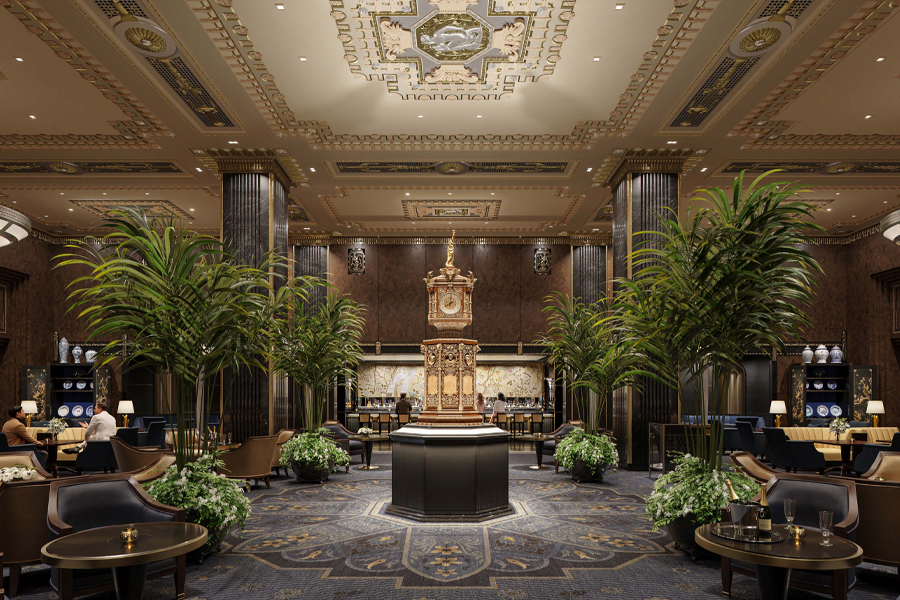Central Oregon Is a Golfer’s Paradise
The once sleepy town of Bend, Oregon, is one of the great sports and leisure centers of the West
by Jeff Wallach
October 2, 2023
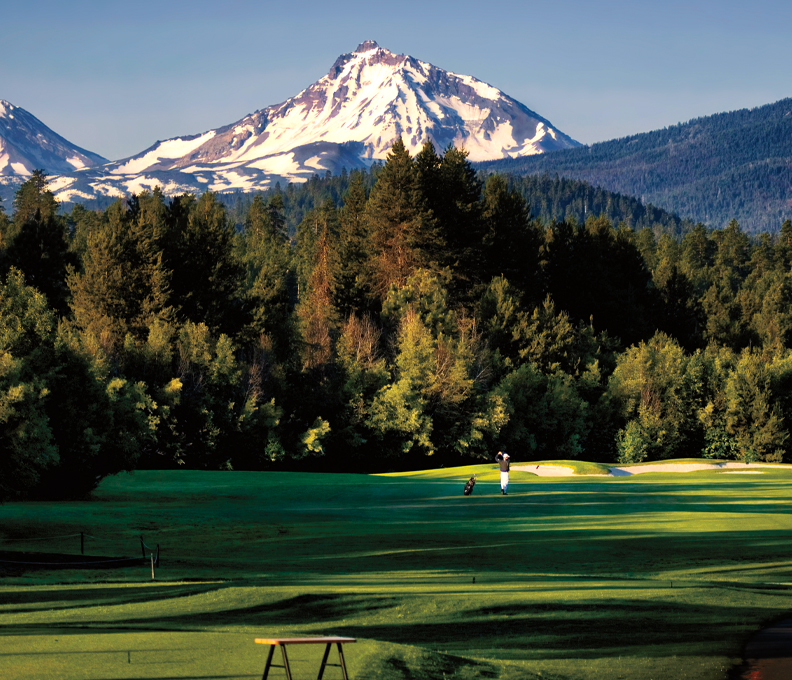
Big Meadow course at Black Butte Ranch, Sisters, Oregon / Photo: Courtesy of Black Butte Ranch
The high-desert town of Bend, Oregon, lies 175 miles south and east of Portland. The key direction here, however, is “east”—as in east of the Cascade Mountains, which protect the central part of the state from Pacific storms, providing this area at an elevation of 3,600 feet with something like 300 days of sunshine annually. Today, the once sleepy town is one of the great sports and leisure centers of the West, giving up nothing to places such as Aspen or Jackson. A haven for skiers, mountain bikers, runners and other athletes, it’s also home to a portfolio of world-class creative breweries. Oh, and possibly the most diverse collection of golf venues anywhere—with mountain courses, traditional links, heathland layouts and routings carved through ponderosa pine or pinyon-juniper forests all vying for your Pro V1s.
Many courses claim a connection to the game’s Scottish roots. In Bend, this is most true at Tetherow resort, with a course designed by renowned Scottish architect David McLay Kidd. Tetherow features wall-to-wall fescue grass—the same used on most Scottish links—to lend the surface a firm, fast feel that encourages shots played along the ground. Pot bunkers, ragged full-sized bunkers, knobs and knolls must all be negotiated on the way to large, contoured greens that call for creative shotmaking.
One Scottish-accented theme repeats itself: Don’t necessarily aim at the flagsticks, or even the centers of the greens. For despite its inland location, this is a links course in spirit and should be played using the territory to move your ball toward the hole. First-timers cannot possibly figure out where to hit some of the shots on Kidd’s crafted golf puzzles; at some point you’ll make an error either in tactics or execution, which is part of the fun.
Number 17 presents the best photo-op. The hole tunnels through a sunken pumice quarry to the smallest green Kidd ever built. His intention was for players to knock tee shots into the steep slope behind the cupping areas so that the ball will trickle back toward the pin. Seventeen other terrific holes await exploration and offer the chance to utter the word “bollocks” if you fail to make par.
Just in case the golf itself isn’t enough fun, Tetherow offers a chance to traverse the sublime terrain on several unique types of transportation. The GolfBoard is a light electric-powered surfboard. The Finn Scooter, which I skeptically agreed to ride, allowed me to feel hip and cool while moving me quickly along the fairways in a fun way without the clunky camaraderie of a traditional golf cart. After golf, make Tetherow’s 50-room hotel your base of operations for exploring the entire region. The deep luxury includes leather sofas in front of fireplaces, balconies overlooking the grassy expanse of the golf course, soaking tubs, and even artwork in the shower.
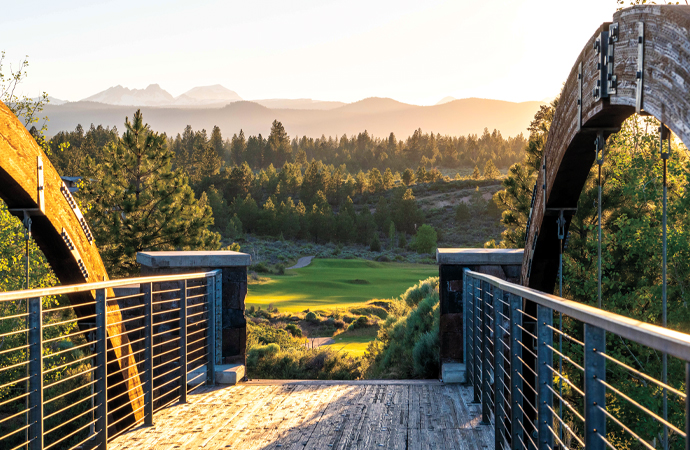
Tetherow, Bend / Photo: Courtesy of Brian Oar
Surrounded by terrain that begs to be explored, Pronghorn at Juniper Preserve is as intoxicating as the high-desert air. The 7,460-yard Jack Nicklaus golf course provides a perky tour of local geography. Holes play directly toward or frame such features as Smith Rock and the Three Sisters. While it reflects the designer’s typical complexity and no small degree of difficulty, Nicklaus took some risks here in the form of split fairways, blind shots, grassy swales, crowned greens and other architectural prestidigitation, nearly all of which pay off on this unpredictable layout.
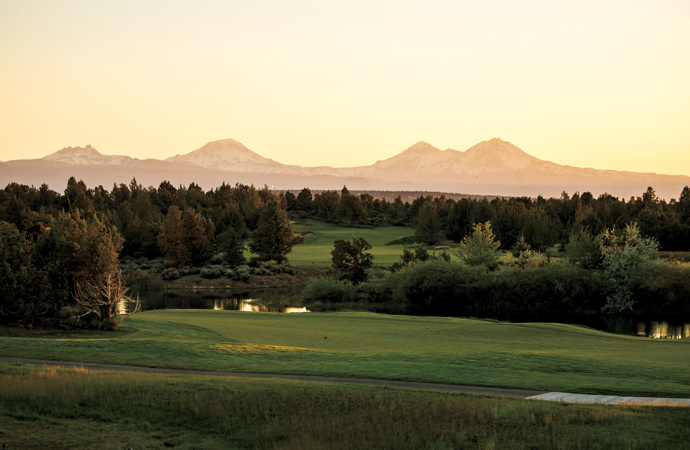
Pronghorn at Juniper Reserve, Bend / Photo: Courtesy of Visit Central Oregon
Built atop an undulating lava flow, Pronghorn plays firm and fast with crisp transitions. Pot bunkers dot immaculate fairways. Pod tees float above islands of wildflowers. Canny players will punch run-up shots to some of the canted greens, the surfaces of which are as pure as mountain water—and sometimes protected by it.
The property also boasts an impressive clubhouse designed in the style of the West’s great nation-al-park lodges, a children’s camp and adult-adventure program, a spa and fitness center, and other attractions that will enhance your stay. Golfers with some street cred may also obtain access to the private Tom Fazio golf course, which features a lava tube on the par-three eighth hole that also serves as a wine cave.
South of Bend, Sunriver Resort lies at the center of one of the most delightful family-friendly communities you’ll ever visit. There’s much more to this resort than just its 63 stellar holes of golf (including the unpretentious Caldera Links nine-holer).
Long a popular destination for Portlanders, Sunriver entered the national golf conversation with Crosswater—600 acres of Bob Cupp-de-signed target golf where bent-grass fairways, tees and greens offset bluegrass and golden fescue, and where the routing winds through meadows, among stately ponderosa pines and across bird-filled wetlands. Add in the Little Deschutes River and its murmuring companionship (holes cross it seven times), and Crosswater may provide the most visually startling round you’ve ever lost two sleeves of balls on. The architecture is reminiscent of the best British heathland courses—if Britain boasted 10,000-foot snowcapped black volcanic peaks.
Sunriver also offers two additional golf courses. The underrated Woodlands, cleverly designed by Robert Trent Jones, Jr., winds through an upscale housing development. The wide-open Meadows course once elicited a “meh” until John Fought took a page from the game’s great architects from the 1920s and ’30s and turned the friendly, undistinguished layout into a modern and challenging classic.
And there’s no shortage of entertainments after golf—bike trails (the Deschutes River Trail un-furls along 11 miles of meadows, black lava, pine forests and waterfalls on the way to Bend), stables, a marina, nature center, spa, fishing and a raft of other action sports, including rafting. Stay in the sleek River Lodge, the highest level of luxury on property.
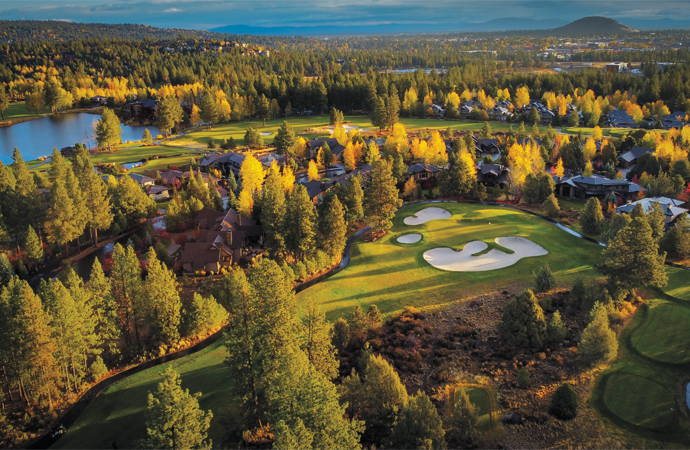
Second hole at Broken Top Club, Bend, Oregon / Photo: Courtesy of Ethan Erickson
For private-club members who know how to access another private course, Broken Top Club may be the best in Bend for conditioning and the crazy variety of holes climbing in and out of forested canyons and offering glimpses of distant peaks. Tom Weiskopf and Jay Morrish’s masterpiece wends through the familiar Central Oregon topography of meadows, ponderosas, swelling hills and huge rock outcroppings while presenting a thinking person’s course concocted with the highest degree of architectural style. Holes are variously perky, entertaining, exhilarating and purely gorgeous, such as number five—a long downhill par three with a lake and sand complex left of the green and a couple of stately trees standing guard to the right. The signature 11th hole features a welcoming fairway that you must chew up a lot to have a chance at hitting the green, perched above a 45-foot vertical wall of pumice. If you’re looking to start an argument, try discussing the controversial hole in the aptly named great room in a clubhouse featuring raw-beamed construction and lots of leather and print fabrics.
At Black Butte Ranch, 45 minutes from Bend, two layouts are lined by throngs of trees. Few courses have benefited more from a renovation than Black Butte’s Glaze Meadow. Although beloved as one of the earliest in the region since its 1982 opening and admired for its impressive views, Glaze was long known as having one of the worst opening holes ever built. But prolific architectural master Fought implemented a $3.75 million overhaul, and the revamped layout—carving through corridors of ponderosa and aspen and playing over rocky streams, wetlands and natural areas—has made the course its best possible self.
Fought’s work extended the short course to more than 7,000 yards, rebuilt the greens, and improved sight lines and shotmaking options. Square tee boxes, elevated putting surfaces, deep grass-faced bunkers and enough doglegs to build at least two dogs lend a classic feel from the era of golf’s Golden Age that Fought has perfected as well as if he’d lived a hundred years ago. The resort’s Big Meadow course, originally designed by Robert Muir Graves in 1970, has been equally well renovated by Damian Pascuzzo. A new $20 million clubhouse features soaring construction and walls of glass nearly as big as the mountains beyond. Enjoy a rustic menu including steaks, steelhead and other Northwest specialties in what will surely be one of the highest-ranked kitchens in Central Oregon.

